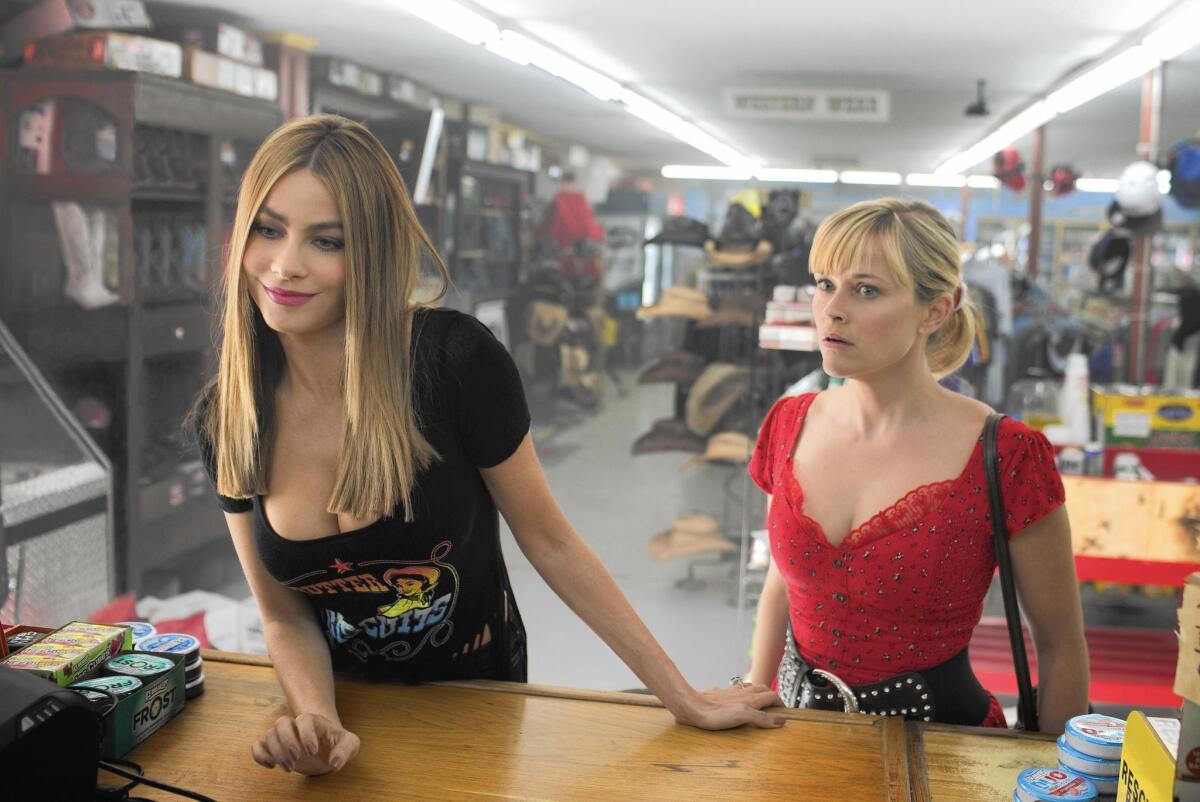So many summer movies, so few female directors

“Hot Pursuit,” starring Sofia Vergara, left, and Reese Witherspoon, was one of only two big summer movies directed by a woman. The other: “Pitch Perfect 2.”
- Share via
It’s summer blockbuster season, when studios release big-budget movies featuring animatronic dinosaurs, ant-sized superheroes and a talking stuffed bear. But there’s one thing moviegoers will see hardly any of this summer — films directed by women.
Among the 35 movies included on a Hollywood Reporter list of the summer’s most anticipated movies, only two have a woman at the helm: the Reese Witherspoon and Sofia Vergara comedy “Hot Pursuit” and “Pitch Perfect 2.”
Data out of San Diego State University showed that in 2014, women made up only 7% of directors of the 250 highest-grossing films. That number is actually two percentage points lower than it was in 1998.
Those numbers have led to mounting pressure on the industry to address the disparity. In June, Supreme Court Justice Ruth Bader Ginsburg said in an interview that an upcoming biopic about her had been delayed because Natalie Portman, who will play Ginsburg in the film, had insisted on a female director.
And in May, the American Civil Liberties Union sent a letter to the U.S. Equal Employment Opportunity Commission and other government agencies requesting that investigations into the movie industry’s failure to hire more female directors.
“The large studios have virtually shut women out of directing big-budget movies for years,” the ACLU wrote, “and the problem is not improving with time.”
Martha Lauzen, executive director of the Center for the Study of Women in Television and Film at San Diego State University, said it could take that kind of action at the regulatory level to get the industry to change.
“That was pretty big news,” said Lauzen, who has collected data on gender in the industry for nearly 20 years. “Something like the EEOC coming in to take a look around, that’s probably what it’s going to take to move this issue forward.”
Plenty of women graduate from film school, so the problem isn’t that few are pursuing such careers, Lauzen said. She also doesn’t buy the idea that the issue is actually just the industry’s aversion to hiring less experienced directors. Colin Trevorrow, who directed the recent blockbuster “Jurassic World,” had helmed only one other feature film previously. “He was a risk!” Lauzen said.
Rather, she says, the problem lies with bias in society and in an industry that has long done as it pleases. “We’re talking about a very high-status, high-profile kind of business that has historically had virtually no accountability for its hiring practices,” Lauzen said. “Everything is bigger in the film industry, including egos.”
Lauzen’s research has shown that the only key behind-the-scenes job category that is worse for women than directors is cinematographers, only 5% of whom are female. Directors and cinematographers are the most “male-identified roles,” she said, perhaps because of the highly technical, equipment-driven nature of the job or, in the case of directors, their position of influence.
“Directors are thought of as being leaders on the set, and I don’t think we can discount the power of perception,” Lauzen said. “As a culture, we are clearly grappling with how to react to women in positions of power.”
Women do better when it comes to independent films, rarely the kind of movies that bring box-office gold. They directed 23% of the films at prominent festivals over the last two years.
At the Sundance Film Festival in particular, their share of the films have climbed to 27%, according to data from a USC study, commissioned by Sundance Institute and Women in Film LA.
Meanwhile, the percentage of female directors among the 100 top-grossing films is declining. It recently reached an extraordinary low of 1.9%.
The numbers aren’t any better when it comes to television. Data from the Directors Guild of America put the percentage of TV episode directors over the last two years who were women at just 14%. And only 2% were minority women.
Jena McGregor writes a daily column analyzing leadership in the news for the Washington Post’s On Leadership section.
More to Read
Inside the business of entertainment
The Wide Shot brings you news, analysis and insights on everything from streaming wars to production — and what it all means for the future.
You may occasionally receive promotional content from the Los Angeles Times.










